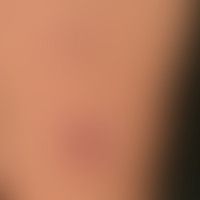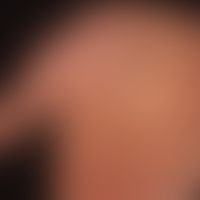Image diagnoses for "Plaque (raised surface > 1cm)"
571 results with 2867 images
Results forPlaque (raised surface > 1cm)

Lichen sclerosus extragenital L90.0
Lichen sclerosus extragenitaler: Diffuse, veil-like, only slightly consistency increased sclerosis of the skin, in case of less inflammatory Lichen sclerosus.

Lichen sclerosus of the penis N48.0
lichen sclerosus of the penis: encircled, several discrete, veil-like, little sharply defined, whitish spots and plaques. these have not been noticed so far. the foreskin is sclerosed and slightly constricted like a band (see bar markings). painful tears (arrow markings) occur after intercourse. finally, "pain after intercourse" led to a visit to the doctor!

Necrobiosis lipoidica L92.1
Necrobiosis lipoidica: Medal-shaped plaques with pronounced central atrophy and bizarre translucent vascular structures.

Tinea inguinalis B35.6
Tinea inguinalis: plaques that have existed for several months, coarse lamellar scaling and moderately itchy. Mycological evidence of T. rubrum.

Dyskeratosis follicularis Q82.8
Dyskeratosis follicularis. infestation of the Rima ani. chronic, intertriginous, whitish sooty, blurred, macerated, superficially rough, clearly increased in consistency, itchy and unpleasant smelling plaques. peripherally the characteristic picture of dyskeratosis follicularis with disseminated red or red-brown papules. on the left side 2 melanocytic nevi.

Mycosis fungoides C84.0
Special form: Mycosis fungoides, folliculotropic. 3-year-old clinical picture with strongly itchy, moderately sharply defined, follicular red plaques. secondary findings: multiple melanocytic nevi.

Vasculitis leukocytoclastic (non-iga-associated) D69.0; M31.0
Vasculitis, leukocytoclastic (non-IgA-associated). multiple, acute, symmetric, since 2 weeks existing, localized on both lower legs, irregularly distributed, 0.1-0.2 cm large, sharply defined, symptomless, hemorrhagic spots and blisters as well as beginning incrustations.

Melanosis neurocutanea Q03.8

Keratosis palmoplantaris cum degeneratione granulosa Q82.8

Lichen planus (overview) L43.-
Lichen planus actinicus: anularsmaller lesions and merged into larger map-like borderline plaques; in the prominent borderline area the violet shade of lichen "ruber" is found.

Larva migrans B76.9
Larva migrans. linear plaque, subepidermally situated, tortuous, constantly itching gait on the right hollow foot. conspicuously in the area of the gait structures described blister formation.

Sarcoidosis of the skin D86.3
Sarcoidosis, subcutaneous nodular form:known pulmonary sarcoidosis; skin findings: subcutaneously and cutaneously located nodules and plates which can be easily distinguished from the surrounding area and which slide on the support.

Toxic epidermal necrolysis L51.2
Toxic epidermal necrolysis. emergency hospitalization of a highly febrile (temp. 39.5 °C) 78-year-old woman with hemorrhagic, areal, epidermal necrolysis in the area of the left arm after ingestion of vancomycin. significantly reduced general condition. it turned out that the patient had received allopurinol and ampicillin for the first time a few days before.

Chronic actinic dermatitis (overview) L57.1
Dermatitis chronic actinic: Severe extensive, permanently itchy eczema reaction of the entire face with intensification of the eyelid regions. improvement in the winter months. recurrence with low UV irradiation.

Xanthelasma H02.6
Xanthelasma: excessive findings. broad-based, symptom-free, yellow, soft plaques and nodules on the upper and lower eyelids. no disturbances of the fat metabolism.









